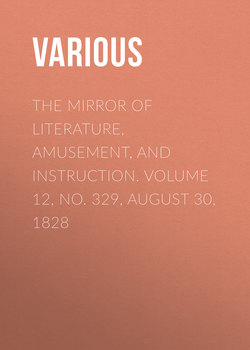Читать книгу The Mirror of Literature, Amusement, and Instruction. Volume 12, No. 329, August 30, 1828 - Various - Страница 6
NEW CHURCH, BUILDING AT STAINES
INTRODUCTION OF SILK INTO EUROPE
Оглавление(For the Mirror.)
The frequency of open hostilities between the Emperor of Constantinople and the monarchs of Persia, together with the increasing rivalry of their subjects in the trade with India, gave rise to an event which produced a considerable change in the silk trade. As the use of that article, both in dress and furniture, became more general in the court of the Greek emperors, who imitated and surpassed the sovereigns of Asia in splendour and magnificence; and as China, in which, according to the concurring testimony of oriental writers, the culture of silk was originally known, (Herlelot. Biblioth. Orient.), still continued to be the only country which produced that valuable commodity; the Persians improving the advantages which their situation gave them over the merchants from the Arabian Gulf, supplanted them in all the marts of India, to which silk was brought by sea from the east. Having it likewise in their power to molest or to cut off the caravans, which, in order to procure a supply for the Greek empire, travelled by land to China through the northern provinces of their kingdom, they entirely engrossed that branch of commerce. Constantinople was obliged to depend on the rival power for an article which luxury reserved and desired as essential to elegance. The Persians, with the usual rapacity of monopolists, raised the price of silk to such an exorbitant height, that the Emperor Justinian eager, not only to obtain a full and certain supply of a commodity which was become of indispensible use, but solicitous to deliver the commerce of his subjects from the exactions of his enemies, endeavoured, by means of his ally, the christian monarch of Abyssinia, to wrest some portion of the silk trade from the Persians. In this attempt he failed; but when he least expected it, he, by an unforeseen event, attained in some measure (A.D. 55.) the object which he had in view. Two Persian monks having been employed as missionaries to some christian churches which were established (as we are informed by Cosmas) in different parts of India, had penetrated into the country of the Seres, or China. There they observed the labours of the silk-worm, and became acquainted with all the arts of men in working up its productions into such a variety of elegant fabrics. The prospect of gain, or perhaps an indignant zeal excited by seeing this lucrative branch of commerce engrossed by unbelieving nations, prompted them to repair to Constantinople. There they explained to the emperor the origin of silk, as well as the various modes of preparing and manufacturing it—mysteries hitherto unknown, or very imperfectly understood in Europe, and encouraged by his liberal promises, they undertook to bring to the capital a sufficient number of those wonderful insects to whose labours man is so much indebted. This they accomplished by conveying the eggs of the silk-worm in a hollow cane. They were hatched by the heat of a dunghill; fed with the leaves of a wild mulberry-tree, and they multiplied and worked in the same manner as in those climates where they first became objects of human attention and care. Vast numbers of these insects were soon reared in different parts of Greece, particularly in the Peloponnesus. Sicily afterwards undertook to breed silk-worms with equal success, and was imitated from time to time in several towns of Italy. In all these places extensive manufactures were established and carried on with silk of domestic production. The demand for silk from the East diminished, of course. The subjects of the Greek emperors were no longer obliged to have recourse to their enemies, the Persians, for a supply of it; and a considerable change took place in the nature of the commercial intercourse between Europe and India.
